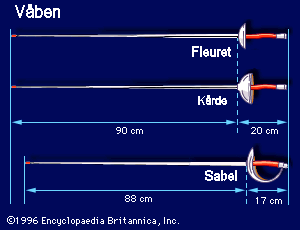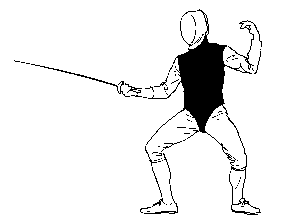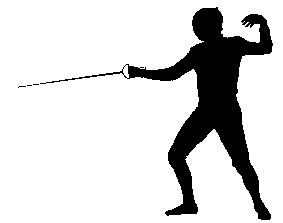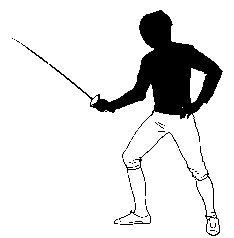Short about fencing
Below is a short introduction to the weapons and equipment that is used in modern sport fencing
Weapons in sport fencing
Three different weapons are used in modern fencing. That is épee, foil and sabre.

Foil

Length: Max. 110 cm. The blade is 90 cm.
Area of Attack: Torso
Type: Stab weapon.
Touche weight: 500 g
Right of attack: Yes
The foil is in many ways a light version of the épee. But the reduced area of attack and the rules of attack causes the actual fencing to be different. Generally foil fencing is faster than épee, with more tempo and more attack/parry sequences. There is also more blade contact than is generally seen in épee fencing.
In old times the foil had a piece of leather around the tip to prevent injuries when training, giving it the french name of Fleuret, for flower (fleur), as the leather protection resembled a closed flower.
When fencing electric fencing, the fencers wears a vest with metalling surface, and
Fleuretten har fået sit navn fra det stykke læder man i gamle dage viklede om spidsen på fleuretterne. Det lignede nemlig en sammenfoldet blomst.
Når der fægtes elektrisk på fleuret bære fægterne en elvest, og kun touché der rammer vesten registres som gyldige.
Épee

Length: Max. 110 cm. The blade is 90 cm.
Area of attack: Whole body
Type: Stab weapon
Touche weight: 750 g.
Right of attack: No
This is a modern version of a real duelling weapon, that where used in 1500. The épee have a contact on the tip that have to be pushed with at least 750 g for the fencer to score a hit, this should be the same that weight that would be required by a pointed épee to penetrate skin and draw blod.
The épee have no right of attack. If both fencers attacks and scores at the same time then both fencers gets points.
The épee is the heaviest and slowest of the three weapons. In épee bouts there is often less blade contact than in foil.
Sabre

Length: Max. 105 cm. The blade is 88 cm.
Area of attack: Everything above the belt
Type: Slashing weapon
Touche weight: – (no contact to press).
Right of attack: Yes
Sabre is the only weapon in modern sport fencing that is a slashing weapon. It is a modified version of the cavalry sabre, but have changed a lot.
The sabre area of attack is the upper body, the only part of the body open to attack when riding.
Sabre fencing normally have the highest tempo of the three weapons, and can with less trained fencers to outsiders look like two people clashing togetter again and again.
When fencing electric the fencers wear vests, gloves and mask with metallic surfaces, to ensure that only these areas register as valid touches. Hits on other bodyparts stops the bout
Equipment
Mask
The fencing mask covers the face, and most have metal net in front of the face. More and more masks with glasfronts appears, and are required for the final bouts in International competitions.
The masks have to be able to withstand a pressure of 1600 N. This is tested before major competitions.
Sabre fencers uses special masks that are able to conduct an electric current.
Jacket
The jackets are made of special fabrics of the same kind used to make bulletproof vests. They have to be able to block a pressure of 800 N. Most of the jackets are still thin enough that fencing can give blue marks on the arms.
Trouses
Actually knickers. They trouses stops just under the knee and can like the jacket withstand a pressure of 800 N.
Plastron
A vest, covering the breast and at least the upper part of one arm. This is not required in all competition, but is required in all International competition. The plastron must be able to handle a pressure of 800 N.
Glovers
Fencers wear one glove, on the hand holding the weapon. The glove can be made of leather or special material. After each fight the fencers shake hand, this is always with the hand that have no glove.
Sabre fencers have a special glove with metal wire to ensure that hit registres as valids.
El-vest
Both foil and sabre fencers wears an metal wire vest, to ensure hits on valid areas of the body registers when fencing electric fensing
Wire
To register scored hits each fencer is connected to an sounding device with a long electric wire. The wire is connected to the weapon and a wire runs along the arm and out on the back. There have been some experiments using wireless technics, but they are currently not in widespread use. This may change as the technology becomes more reliable and cheap.
The piste

The piste is marked 2 m on each side of the middle, this is the starting position for the fencers. There are also a warning line 2 meters before the end of the piste. If the fencers leaves the piste the bout stops. If the fencer leaves the piste by backing out of the end the opponent gets a point.